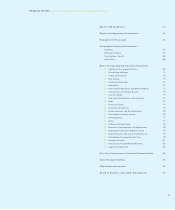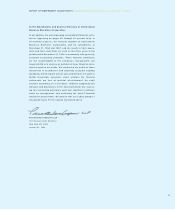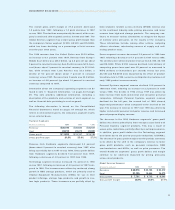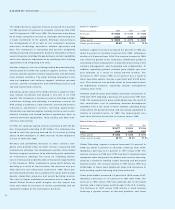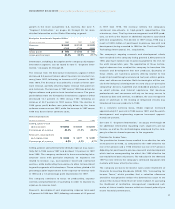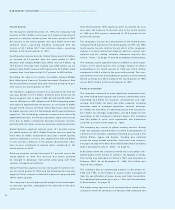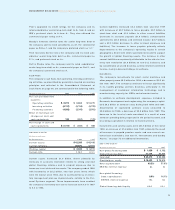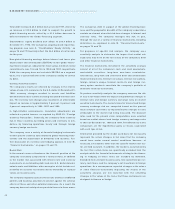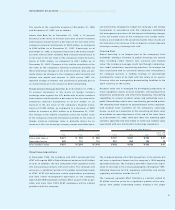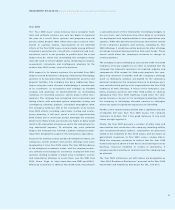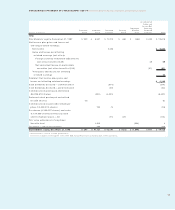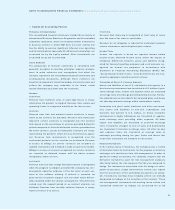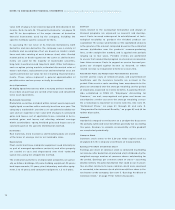IBM 1998 Annual Report Download - page 62
Download and view the complete annual report
Please find page 62 of the 1998 IBM annual report below. You can navigate through the pages in the report by either clicking on the pages listed below, or by using the keyword search tool below to find specific information within the annual report.
Total debt increased $2.5 billion from year-end 1997, driven by
an increase of $3.9 billion in debt to support the growth in
global financing assets, offset by a $1.4 billion decrease in
debt not related to the Global Financing segment.
Stockholders’ equity declined $0.4 billion to $19.4 billion at
December 31, 1998. The company’s ongoing stock repurchas-
ing program (see note O, “Stockholders’ Equity Activity,” on
pages 76 and 77) basically offset the $6.3 billion of net income
for the year.
Non-global financing earnings before interest and taxes plus
depreciation and amortization (EBITDA) to non-global financ-
ing interest expense, adjusted for future gross minimum rental
commitments, was 15x and 14x in 1998 and 1997, respectively.
While the company does not calculate EBITDA on a segment
basis, it is a useful indicator of the company’s ability to service
its debt.
Currency Rate Fluctuations
The company’s results are affected by changes in the relative
values of non-U.S. currencies to the U.S. dollar. At December 31,
1998, currency changes resulted in assets and liabilities
denominated in local currencies being translated into more dol-
lars. The currency rate changes also resulted in an unfavorable
impact on revenue of approximately 2 percent, 5 percent and
3 percent, respectively, in 1998, 1997 and 1996.
In high-inflation environments, translation adjustments are
reflected in period income, as required by SFAS 52, “Foreign
Currency Translation.” Generally, the company limits currency
risk in these countries by linking prices and contracts to U.S.
dollars, by financing operations locally and through foreign
currency hedge contracts.
The company uses a variety of financial hedging instruments
to limit specific currency risks related to global financing trans-
actions and the repatriation of dividends and royalties. Fur-
ther discussion on currency and hedging appears in note M,
“Financial Instruments,” on pages 74 and 75.
Market Risk
In the normal course of business, the financial position of the
company is routinely subjected to a variety of risks. In addition
to the market risk associated with interest rate and currency
movements on outstanding debt and non-U.S. dollar denomi-
nated assets and liabilities, other examples of risk include col-
lectibility of accounts receivable and recoverability of residual
values on leased assets.
The company regularly assesses these risks and has established
policies and business practices to protect against the adverse
effects of these and other potential exposures. As a result, the
company does not anticipate any material losses in these areas.
The company’s debt in support of the global financing busi-
ness and the geographic breadth of the company’s operations
contain an element of market risk from changes in interest and
currency rates. The company manages this risk, in part,
through the use of a variety of financial instruments including
derivatives, as explained in note M, “Financial Instruments,”
on pages 74 and 75.
For purposes of specific risk analysis, the company uses
sensitivity analysis to determine the impact that market risk
exposures may have on the fair values of the company’s debt
and other financial instruments.
The financial instruments included in the sensitivity analysis
consist of all of the company’s cash and cash equivalents,
marketable securities, long-term non-lease receivables,
investments, long-term and short-term debt and all derivative
financial instruments. Interest rate swaps, interest rate options,
foreign currency swaps, forward contracts and foreign cur-
rency option contracts constitute the company’s portfolio of
derivative financial instruments.
To perform sensitivity analysis, the company assesses the risk
of loss in fair values from the impact of hypothetical changes in
interest rates and foreign currency exchange rates on market
sensitive instruments. The market values for interest and foreign
currency exchange risk are computed based on the present
value of future cash flows as impacted by the changes in rates
attributable to the market risk being measured. The discount
rates used for the present value computations were selected
based on market interest and foreign currency exchange rates
in effect at December 31, 1998 and 1997. The differences in this
comparison are the hypothetical gains or losses associated
with each type of risk.
Information provided by the model used does not necessarily
represent the actual changes in fair value that the company
would incur under normal market conditions because, of
necessity, all variables other than the specific market risk fac-
tor are held constant. In addition, the model is constrained by
the fact that certain items are specifically excluded from the
analysis while the financial instruments relating to the financ-
ing or hedging of those items are included by definition.
Excluded items include leased assets, forecasted foreign cur-
rency cash flows, and the company’s net investment in foreign
operations. As a consequence, reported changes in the values
of some financial instruments impacting the results of the
sensitivity analysis are not matched with the offsetting
changes in the values of the items that those instruments are
designed to finance or hedge.
MANAGEMENT DISCUSSION International Business Machines Corporation and Subsidiary Companies
60



